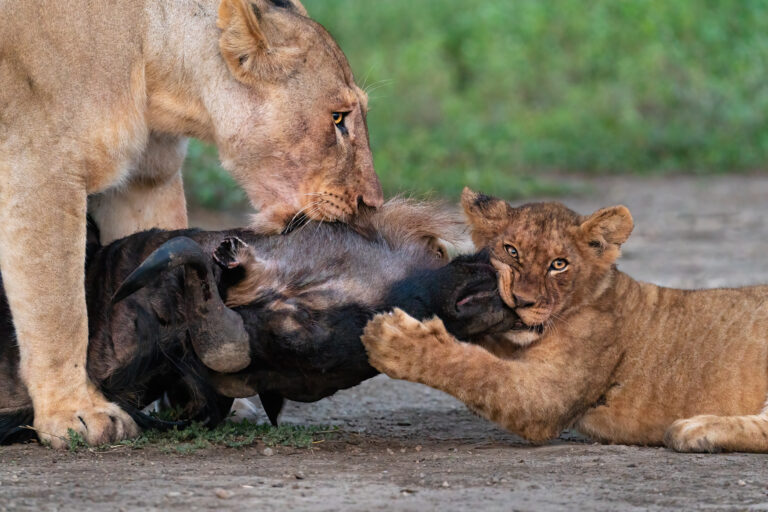





Home to one of nature’s most jaw-dropping natural events, Ndutu offers a safari experience second to none. Each year between the months of January to March the great migratory wildebeest herds of East Africa gather on the plains surrounding Lake Ndutu for one single purpose. Here, they give birth to about 400 000 calves within a short space of time, filling the Ndutu plains with an abundance of young innocent life.
It is this natural wonder of nature that not only draws nature lovers and wildlife photographers from around the world, but also attracts the top predators of the region, specifically lion, cheetah, hyena, leopard and even African wild dog. This abundance of predator activity, new life, a stunning variety of landscapes and authentic tented camp experiences make Ndutu a must-visit!
To the North of the Ndutu Conservation Area lies the famous Serengeti National Park. Ndutu shares an open border with the Serengeti allowing wildlife to move freely between the two regions. In the Serengeti, off-roading and getting closer to wildlife away from the main roads is strictly prohibited. In Ndutu though, that’s not the case. You have the luxury of spending time with big cats and great herds off the main roads, an epic experience that allows you to get closer to the action than ever before. It is this exact feature that makes Ndutu such a quality photographic destination for wildlife photographers.
Getting There:
You would typically arrive in Tanzania via Kilimanjaro International Airport. Flights from Kilimanjaro or Arusha, the nearby city, fly in the direction of Ndutu on a daily basis. There’s an airport in Ndutu with a gravel runway and the flight itself is just over an hour long.
Alternatively, you could take the more scenic route.
We enjoy spending a night in Arusha. Our guests typically arrive from far-away destinations and may be a little tired on that first day, or perhaps get in too late to catch a direct flight into Ndutu. There are wonderful accommodation options in Arusha. The region is well known for coffee and many of these plantations now offer establishments and guesthouses that’ll take care of all your accommodation needs as you overnight and get yourself ready for a safari experience further North.
If you arrive early it’s worth considering a quick visit to Arusha National Park, situated on the outskirts of the city and giving you great views of Mount Meru and also affording you the opportunity to see and photograph Black & White Colobus Monkeys.
Driving directly from Arusha to Ndutu can take some time. It’s strongly advised to visit one or more safari parks along the way, even if just for a night or two. Between Arusha and Ndutu you’ll find 3 well known areas for you to explore.
The first is Lake Manyara National Park, literally on the border with the city itself. It offers some wonderful game viewing opportunities and a great opportunity to settle in to the rhythm of safari.
Close to Manyara lies Tarangire National Park, one of my personal favourite regions in Tanzania. It’s highly seasonal with a distinct summer (green) and winter (dry) season. There’s ample accommodation options and it’s well worth a 2 or 3 night stay.
The most famous of the 3 would be the Ngorongoro Crater. To get to Ndutu you would drive across the rim of this famous landmark, one of Africa’s natural wonders. Once you get to the top and you see the views down on to the floor of the crater, you’ll definitely want to stay and explore some more. In fact, on most of our safaris to Ndutu or the Serengeti, we include a stay here because it’s an incredible sight to see and the game viewing & the scenery is captivating.
It takes 3 or 4 hours to reach the Ngorongoro Crater from Arusha, and another 2 hours from the crater to Ndutu itself.





The Features of Ndutu
I find Ndutu to be incredibly varied. It has a wide array of landscapes and features that not only amaze visitors, drawn in by the natural beauty of the land, but also allows for a wide variety of wildlife & birds to occur.
The first thing you’ll notice are the vast short-grass plains. It is these exact plains that attract the great herds and affords them the opportunity and space to congregate in magnificent numbers and to give birth. Volcanic ash deposited here by the nearby mountains, including Ngorongoro in its former glory, deeply fertilized the soils surrounding Ndutu. It is these rich soils that produce energy-rich grasses for the mother wildebeests to feed on, further nourishing their milk and the young wildebeest that drink it. They grow stronger faster and are able to take to the road further North with the big herds come April & May.
The great open plains also draw in many predators, both big & small. Cheetah are the most obvious. Ndutu is cheetah country, of that there’s no doubt. The plains perfectly suit their style of hunting and the arrival of the herds means food is abundant and always on offer. Hyenas also frequent the open plains. Often views as lowly scavengers, in Ndutu, you’ll soon see why it is the exact opposite. They are effective hunters and are often found in pursuit of prey on these open plains. It’s also not uncommon to see lions on the plains, although they do prefer the shade offered by the nearby woodlands surrounding Lake Ndutu.
You stand a good chance of seeing Serval and African wild cat on the open plains, especially on the edge of the woodland.
As you drive through the vast open grasslands you’ll soon enter a forest of thorn trees and woodland. These trees, especially when closer to Lake Ndutu itself, grow large and tall and provide a natural beauty to the land. They are also known as umbrella acacias. The woodland surrounds the entire Lake Ndutu and further to the West of the lake, the woodland spans across and around a channel of water flowing out of from two marshlands.
It is the change in landcape – from open short grass plains, to large woodland, that make Ndutu so unique and that offers a home to a variety of animals. Leopards are not to keen to find themselves in the open plains. It’s a risk to their safety, they much prefer being close to large trees in order to evade potential threats. Once you get into the woodland you’ll be well advised to take your time as you scan for leopards lounging around on the big branches of the Umbrella Thorn trees. Lions also frequent the woodland and the pride that occupy the territory on the southern portion of the lake will often take to the trees during the day to siesta. It is a stunning sight to see and one very unique to only a few regions in Africa. It’s not uncommon to see an entire pride sleeping in a tree, including male lions and cubs. It sure is a sight you’ll never forget and for this reason alone, Ndutu should be right up there on your bucketlist of safari destinations to visit.
The woodland offers a fantastic experience. In addition to the big cats there’s a wide variety of birdlife on show, from eagles to starlings and flamingos in the lake nearby. You also stand a great chance of spotting a caracal on the prowl here, an effective predator and the 4th largest cat species in Africa.
A series of lakes can be found in Ndutu as well adding incredible scenery to your experience.
Nasikia Mobile Tented Camp
Why you should visit
Africa’s blessing and the curse is that there are so many incredible reserves and game viewing opportunities on offer. How on earth do you choose? It’s a tough one but one I will make easier as I tell you just why Ndutu stands out above so many others.
- Ndutu is seasonal in terms of the game viewing experience it offers. You are welcome to visit at any time of the year, but it truly comes to life from January to April each year. This is when the great migration arrives en masse and takes over the entire region. This intensifies the game viewing experience immensely & makes it easy to pick a time to visit.
- We all love big cats and Ndutu has all of them. During peak season Ndutu can deliver some of the best lion & cheetah viewing in Africa. With the arrival of the herds and the birthing season of the wildebeest, there’s plenty for them to hunt and they are very active.
- The smaller cats are often the most difficult to track down on safari. It’s very difficult to see them as they are usually highly nocturnal and secretive throughout most of their range. In Ndutu however your chances of quality Serval and Caracal sightings are very high, especially if you spend a week or more.
- There are great, authentic tented camps to choose from. These camps are really well placed and you will often find yourself right in the middle of the great herds and in the action, right from camp.
- Ndutu borders the great Serengeti National Park and whatever you could see in there, you’ll see in Ndutu.
- The Ndutu landscape is just stunning. It is incredibly varied and you will enjoy quality wildlife and bird encounters.
- Ndutu finds itself between the Ngorongoro Crater and the Serengeti National Park. This makes both of these iconic regions easy to visit and work in to your Ndutu itinerary. In addition you could visit great places like Tarangire & Lake Manyara National Parks, and you have quick access to Serengeti “hot spots” like Namiri and Seronera.
- There’s a fully functioning airport in Ndutu which makes travel in and out easy & convenient. Simply fly into Kilimanjaro, board a chartered flight at a reasonable cost, and an hour later you will touch down on Ndutu soils.
These are merely a few reasons to visit and I know I can keep you busy with a few more of them. Should you ever have any questions about Ndutu simply connect with us and we will get them answered in no time at all. We also visit Ndutu on small-group photographic safaris and these are really worth considering if this is a place you’d love to see or return back to.
Thanks so much for taking the time to read through this with me. We look forward to hearing from you in the comments below, and we hope to see you out on safari with us soon.
All my best.
















